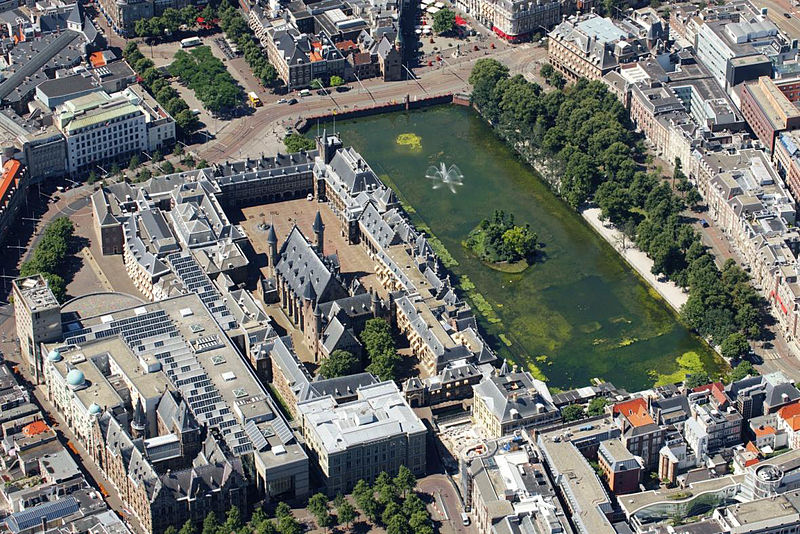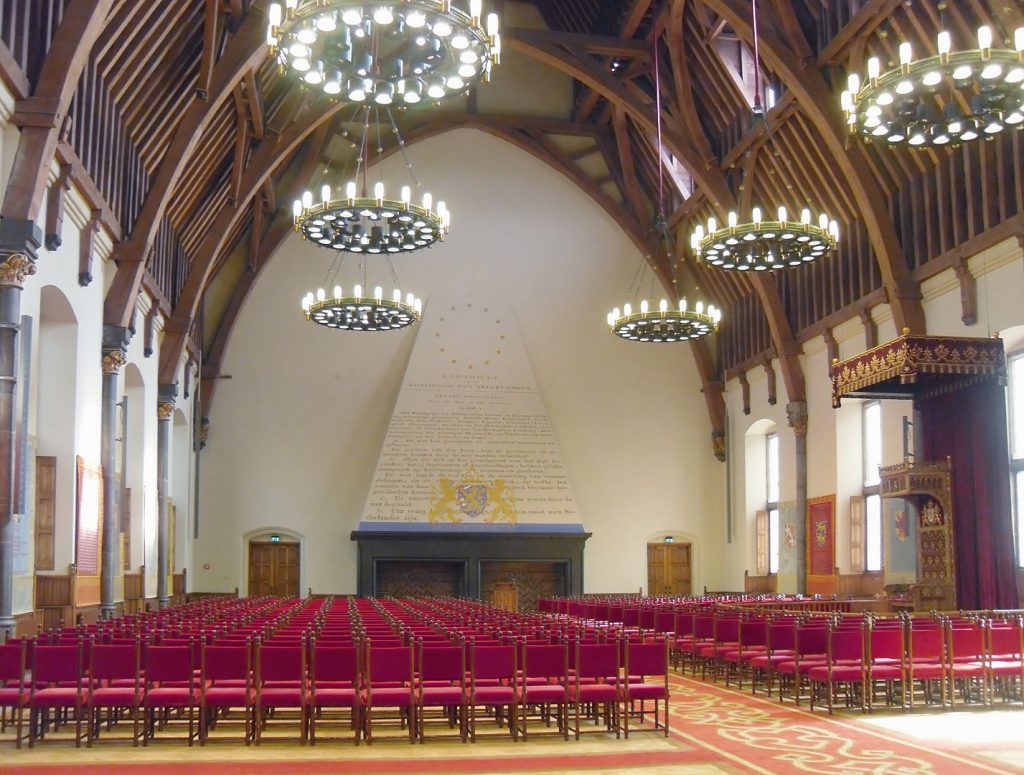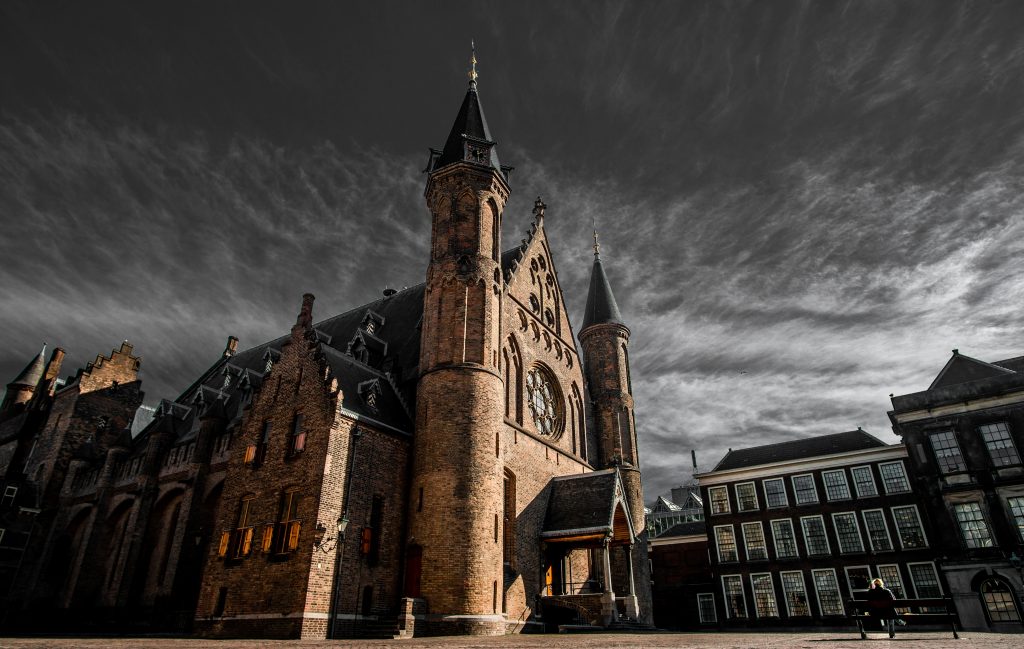Binnenhof: De Ridderzaal Posted by Sten on May 11, 2020 in Culture
The Binnenhof (Inner Court) is the center of the Dutch overheid (government). Located in the heart of Den Haag (The Hague), it oozes Dutch geschiedenis (history) and verhalen (stories). In this series, we’ll go building by building and explore what each is all about. Today, let’s check out the Ridderzaal!
For more posts in the Binnenhof series, click here.
What is the Ridderzaal?
While the Torentje is a small building at the edge of the complex that you might easily oversee, the Ridderzaal is the exact opposite. It is, in fact, the most prominent building in the Binnenhof, and an iconic emblem of centuries of Dutch Politiek (politics). With its two torens (towers) and roosvenster (rose window), it is at the center of the Binnenhof.
The Ridderzaal, which means “Hall of Knights”, is one of the oldest buildings in the Binnenhof. It was built in 1280 and completed around 1288 by the order of Willem II van Holland (William II of Holland). The Ridderzaal is only part of the entire building, which also includes the Rolzaal, Kelderzaal and Lairessezaal. While these are used for smaller meetings and receptions, the Ridderzaal is by far the most noteworthy part of the complex, known as the grafelijke zalencomplex (Hall complex of the counts).
Originally, the Ridderzaal was called Grote Zaal (Great Hall) or Hoge Zaal (High Hall).
The complex was renovated several times over its long life. It used to have flags of the provinces hanging off the ceiling, which are now replaced by wall cloths. The wooden roof construction is not original anymore, either. It was taken down in 1860 and replaced with a cast iron construction, because the architect working on this renovation believed that the wooden construction was too complex and heavy for the time it was built. He assumed it was added later and was not original. As it turned out, it was the original roof he took down!
In 1904, the renovation to its original state from the 13th century was finished, complete with a renewed wooden roof construction. Buildings that were erected around the Ridderzaal, obstructing its view were removed, and the original towers were built again. This is largely what the Ridderzaal still looks like today, with periodic renovations to keep the building intact.
Why does the Ridderzaal matter?
In its early years, the Ridderzaal served as the ontvangstzaal (welcome hall) to the remaining grafelijke zalen (halls of the counts), which lie behind the Ridderzaal. However, when the Republiek (Republic) was founded in 1648, the Ridderzaal was used for all kinds of purposes. It was a markt (market), a wachtruimte (waiting room) for the rechtbank (court of law), which was situated in the grafelijke zalen and was even used for trekkingen (draws) of the Staatsloterij (State lottery).
But things changed again when the Netherlands became a monarchie (monarchy) once again. In 1900, it was decided to restore the Ridderzaal and make it a koninklijke zaal (royal hall). The interior now includes a troon (throne) and the Dutch grondwet (constitution) is written on the haard (fireplace).
In 1994 and 1995, the Eerste Kamer (First Chamber of Parliament) even held their vergaderingen (meetings) in the Ridderzaal, since their own chamber was being renovated.
These days, the Zaal with room for 850 people is most famously used for the annual troonrede (throne speech) on Prinsjesdag (Prince’s Day) on the third Tuesday of September. This troonrede is a speech from the Dutch monarch in which he or she comments on what has happened in the past year and what the plans of the government are for the coming one. The Ridderzaal is on these prinsjesdagen also used for a verenigde vergadering (common meeting) of the Staten-Generaal (States-General), which describes the volksvertegenwoordiging (people’s representation) according to the constitution, which comprises both chambers of Parliament, the Eerste Kamer and Tweede Kamer.
Besides that, it is also used for other official meetings, ceremonies and commemorations. It cannot be rented by private parties, since it is state-owned, and the government can’t meddle with the private sector like that. Currently, one of the adjacent halls, the Rolzaal, is used by the weekly ministerraad (council of ministers). Since it is big enough, the distance required due to the Coronavirus can be respected.
Overall, it is an impressive building with a long history. Being one of the oldest governmental buildings still in use in the world, it is quite a gem!
Have you visited the Ridderzaal before? Do you have impressive buildings like this that is used by your government? Let me know in the comments below!

Build vocabulary, practice pronunciation, and more with Transparent Language Online. Available anytime, anywhere, on any device.






